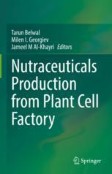Search
Search Results
-
In Vitro Production of Alkaloids
Plants are considered as a potent source of a wide variety of bioactive molecules that can be used for the development of the various pharmaceutical...
-
Natural Compounds Extracted from Medicinal Plants and Their Applications
Plant natural products have played an important role in the lives of human beings for their use as a source of food and medicine. The medicinal...
-
Hairy Root Cultures for Monoterpene Indole Alkaloid Pathway: Investigation and Biotechnological Production
Terpene indole alkaloids (TIAs) comprise a major group of alkaloids as more than 3000 TIAs are known with resilient and beneficial biological...
-
Dimeric
Cinchona alkaloidsNature is full of dimeric alkaloids of various types from many plant families, some of them with interesting biological properties. However, dimeric Cinchona...

-
Molecular diversity of spirooxindoles. Synthesis and biological activity
Spirooxindoles are important synthetic targets possessing extended biological activity and drug discovery applications. This review focuses on the...

-
Synthesis of 9-amino(9-deoxy)epi cinchona alkaloids, general chiral organocatalysts for the stereoselective functionalization of carbonyl compounds
We describe two procedures for the synthesis of primary amines derived from 9-amino(9-deoxy) epi cinchona alkaloids, valuable catalysts used in the...

-
Rutaceous alkaloids as models for the design of novel antitumor drugs
The chemical diversity of alkaloids in the Rutaceae is correlated with biosynthetic pathways involving various aromatic amino acid precursors,...
-
Cinchona alkaloid-based polymer-bound phase-transfer catalysts: Efficient enantioselective alkylation of benzophenone imine of glycine esters
Cross-linked polystyrene-bound and poly(ethylene glycol)-bound phase-transfer catalysts as well as homopolymers of cinchona alkaloid derivatives have...
-

-
Sarcomelicope alkaloids as leads for the discovery of new antitumor acronycine derivatives
The acridone alkaloid acronycine first isolated from Acronychia baueri Schott (Rutaceae) in 1948, was later shown to exhibit a promising activity...
-
Anomalous enantioselectivity in the sharpless asymmetric dihydroxylation reaction of 24-nor-5β-cholest-23-ene-3α,7α,12α-triol: Synthesis of substrates for studies of cholesterol side-chain oxidation
Recently we described a block in bile acid synthesis in cerebrotendinous xanthomatosis (CTX), a lipid storage disease related to an inborn error of...
-

-
Induced responses in three alkaloid-containing plant species
In this paper we test three plant species for the inducibility of their alkaloid production. The plants were heavily damaged by cutting off 50% of...
-
Intracellular Parasites
Intracellular protozoan parasites cause many of the most severe and widespread diseases of man, particularly malaria, leishmaniasis, Chagas’ disease,...
-
Effect of auxin on cytodifferentiation and production of quinoline alkaloids in compact globular structures of Cinchona ledgeriana
Fine cell suspension cultures of
Cinchona ledgeriana produce only very low amounts of quinoline alkaloids. These cultures formed self-propagating... -
The preferential inhibition of Bacillus subtilis spore outgrowth by chloroquine
Chloroquine inhibited the outgrowth of Bacillus subtilis spores at a 10-fold lower concentration than that required to prevent vegetative growth....
-
Tabernaemontana spp.: In Vitro Production of Indole and Biogenetically Related Alkaloids
The family Apocynaceae is probably one of the richest sources of drugs in the plant kingdom. Both alkaloids, e.g. reserpine, vincristine,...
-
Cinchona spp.: Micropropagation, and the In Vitro Production of Quinine and Quinidine
The commercial value of Cinchona comes almost entirely from the alkaloids, quinine and quinidine (Fig. 1), extracted from the bark: a subsidiary use...
-
Toxicity of quinoline alkaloids to cultured Cinchona ledgeriana cells
The toxicity of
Cinchona alkaloids to cell cultures ofC. ledgeriana has been studied in relation to alkaloid uptake and possibilities for selecting... -
The Measurement of Low-Molecular-Weight, Non-Immunogenic Compounds by Immunoassay
The analysis of compounds by immunoassay requires an antibody preparation active against the compound of interest Small molecules (< 1000 daltons) do...
